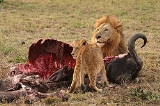
Carnivore
Encyclopedia
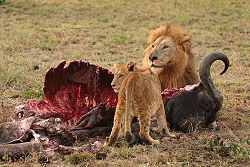
Latin
Latin is an Italic language originally spoken in Latium and Ancient Rome. It, along with most European languages, is a descendant of the ancient Proto-Indo-European language. Although it is considered a dead language, a number of scholars and members of the Christian clergy speak it fluently, and...
, carne meaning 'flesh' and vorare meaning 'to devour')is an organism
Organism
In biology, an organism is any contiguous living system . In at least some form, all organisms are capable of response to stimuli, reproduction, growth and development, and maintenance of homoeostasis as a stable whole.An organism may either be unicellular or, as in the case of humans, comprise...
that derives its energy and nutrient requirements from a diet
Diet (nutrition)
In nutrition, diet is the sum of food consumed by a person or other organism. Dietary habits are the habitual decisions an individual or culture makes when choosing what foods to eat. With the word diet, it is often implied the use of specific intake of nutrition for health or weight-management...
consisting mainly or exclusively of animal
Animal
Animals are a major group of multicellular, eukaryotic organisms of the kingdom Animalia or Metazoa. Their body plan eventually becomes fixed as they develop, although some undergo a process of metamorphosis later on in their life. Most animals are motile, meaning they can move spontaneously and...
tissue
Tissue (biology)
Tissue is a cellular organizational level intermediate between cells and a complete organism. A tissue is an ensemble of cells, not necessarily identical, but from the same origin, that together carry out a specific function. These are called tissues because of their identical functioning...
, whether through predation
Predation
In ecology, predation describes a biological interaction where a predator feeds on its prey . Predators may or may not kill their prey prior to feeding on them, but the act of predation always results in the death of its prey and the eventual absorption of the prey's tissue through consumption...
or scavenging
Scavenger
Scavenging is both a carnivorous and herbivorous feeding behavior in which individual scavengers search out dead animal and dead plant biomass on which to feed. The eating of carrion from the same species is referred to as cannibalism. Scavengers play an important role in the ecosystem by...
. Animals that depend solely on animal flesh for their nutrient requirements are considered obligate carnivores while those that also consume non-animal food are considered facultative carnivores. Omnivore
Omnivore
Omnivores are species that eat both plants and animals as their primary food source...
s also consume both animal and non-animal food, and apart from the more general definition, there is no clearly defined ratio of plant to animal material that would distinguish a facultative carnivore from an omnivore, or an omnivore from a facultative herbivore, for that matter. A carnivore that sits at the top of the foodchain is an apex predator
Apex predator
Apex predators are predators that have no predators of their own, residing at the top of their food chain. Zoologists define predation as the killing and consumption of another organism...
.
Plants that capture and digest insects are called carnivorous plants. Similarly, fungi that capture microscopic animals are often called carnivorous fungi.
Classification
The word "carnivore" sometimes refers to the mammalMammal
Mammals are members of a class of air-breathing vertebrate animals characterised by the possession of endothermy, hair, three middle ear bones, and mammary glands functional in mothers with young...
ian Order Carnivora
Carnivora
The diverse order Carnivora |Latin]] carō "flesh", + vorāre "to devour") includes over 260 species of placental mammals. Its members are formally referred to as carnivorans, while the word "carnivore" can refer to any meat-eating animal...
, but this is somewhat misleading. Although many Carnivora fit the definition of being exclusively meat eaters, not all do. For example, most species of bear
Bear
Bears are mammals of the family Ursidae. Bears are classified as caniforms, or doglike carnivorans, with the pinnipeds being their closest living relatives. Although there are only eight living species of bear, they are widespread, appearing in a wide variety of habitats throughout the Northern...
s are omnivorous
Omnivore
Omnivores are species that eat both plants and animals as their primary food source...
, except for the giant panda
Giant Panda
The giant panda, or panda is a bear native to central-western and south western China. It is easily recognized by its large, distinctive black patches around the eyes, over the ears, and across its round body. Though it belongs to the order Carnivora, the panda's diet is 99% bamboo...
, which is almost exclusively herbivorous, and the carnivorous polar bear
Polar Bear
The polar bear is a bear native largely within the Arctic Circle encompassing the Arctic Ocean, its surrounding seas and surrounding land masses. It is the world's largest land carnivore and also the largest bear, together with the omnivorous Kodiak Bear, which is approximately the same size...
. In addition, many carnivorous species are not members of Carnivora.
Outside the animal kingdom, there are several genera containing carnivorous plant
Carnivorous plant
Carnivorous plants are plants that derive some or most of their nutrients from trapping and consuming animals or protozoans, typically insects and other arthropods. Carnivorous plants appear adapted to grow in places where the soil is thin or poor in nutrients, especially nitrogen, such as acidic...
s and several phyla containing carnivorous fungi
Carnivorous fungus
Carnivorous fungi or predaceous fungi are fungi that derive some or most of their nutrients from trapping and digesting microscopic or other minute animals. More than 200 species have been described, belonging to the phyla Ascomycota, Mucoromycotina, and Basidiomycota...
. The former are predominantly insectivores, while the latter prey mostly on microscopic invertebrate
Invertebrate
An invertebrate is an animal without a backbone. The group includes 97% of all animal species – all animals except those in the chordate subphylum Vertebrata .Invertebrates form a paraphyletic group...
s, such as nematode
Nematode
The nematodes or roundworms are the most diverse phylum of pseudocoelomates, and one of the most diverse of all animals. Nematode species are very difficult to distinguish; over 28,000 have been described, of which over 16,000 are parasitic. It has been estimated that the total number of nematode...
s, amoeba
Amoeba
Amoeba is a genus of Protozoa.History=The amoeba was first discovered by August Johann Rösel von Rosenhof in 1757. Early naturalists referred to Amoeba as the Proteus animalcule after the Greek god Proteus, who could change his shape...
and springtail
Springtail
Springtails form the largest of the three lineages of modern hexapods that are no longer considered insects...
s.
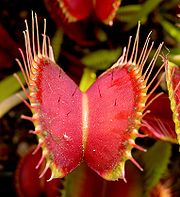
Insect
Insects are a class of living creatures within the arthropods that have a chitinous exoskeleton, a three-part body , three pairs of jointed legs, compound eyes, and two antennae...
s and similar invertebrates primarily or exclusively are called insectivore
Insectivore
An insectivore is a type of carnivore with a diet that consists chiefly of insects and similar small creatures. An alternate term is entomophage, which also refers to the human practice of eating insects....
s, while those that eat fish
Fish
Fish are a paraphyletic group of organisms that consist of all gill-bearing aquatic vertebrate animals that lack limbs with digits. Included in this definition are the living hagfish, lampreys, and cartilaginous and bony fish, as well as various extinct related groups...
primarily or exclusively are called piscivore
Piscivore
A piscivore is a carnivorous animal which eats primarily fish. Piscivory was the diet of early tetrapods , insectivory came next, then in time reptiles added herbivory....
s. Large piscivore
Piscivore
A piscivore is a carnivorous animal which eats primarily fish. Piscivory was the diet of early tetrapods , insectivory came next, then in time reptiles added herbivory....
amphibians were the first vertebrates to conquer land, they evolved 400 million years ago. Insectivores evolved next and predators of other vertebrates after that.
Obligate carnivores
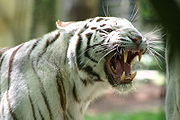
Physiology
Physiology is the science of the function of living systems. This includes how organisms, organ systems, organs, cells, and bio-molecules carry out the chemical or physical functions that exist in a living system. The highest honor awarded in physiology is the Nobel Prize in Physiology or...
required for the efficient digestion
Digestion
Digestion is the mechanical and chemical breakdown of food into smaller components that are more easily absorbed into a blood stream, for instance. Digestion is a form of catabolism: a breakdown of large food molecules to smaller ones....
of vegetable matter and, in fact, some carnivorous mammals eat vegetation specifically as an emetic.
All felids
Felidae
Felidae is the biological family of the cats; a member of this family is called a felid. Felids are the strictest carnivores of the thirteen terrestrial families in the order Carnivora, although the three families of marine mammals comprising the superfamily pinnipedia are as carnivorous as the...
including the domestic cat are obligate carnivores requiring a diet of primarily animal flesh and organs. The ability to produce synthetic forms of essential nutrients such as taurine in the lab has allowed feed manufacturers to formulate foods for carnivores including domestic pets and zoo animals with varying amounts of plant material.
The diet of a hypercarnivore
Hypercarnivore
A hypercarnivore is an animal which has a diet that is more than 70% meat, with the balance consisting of non-animal foods such as fungi, fruits or other plant material. Some examples include the big cats, dolphins, eagles, snakes, marlin, most sharks, and such invertebrates as octopuses and sea...
consists of more than 70% meat, that of a mesocarnivore
Mesocarnivore
A mesocarnivore is an animal whose diet consists of 50–70% meat with the balance consisting of nonvertebrate foods which may include fungi, fruits, and other plant material...
50-70%, and that of a hypocarnivore
Hypocarnivore
A hypocarnivore is an animal that consumes less than 30% meat for its diet, the majority of which consists of nonvertebrate foods that may include fungi, fruits, and other plant material...
less than 30%, with the balance consisting of non-animal foods, which may include fungi, fruit
Fruit
In broad terms, a fruit is a structure of a plant that contains its seeds.The term has different meanings dependent on context. In non-technical usage, such as food preparation, fruit normally means the fleshy seed-associated structures of certain plants that are sweet and edible in the raw state,...
s, and other plant material.
Characteristics of carnivores
Characteristics commonly associated with carnivores include organs for capturing and disarticulating prey (teeth and claws serve these functions in many vertebrates) and status as a predator. In truth, these assumptions may be misleading, as some carnivores do not hunt and are scavengers (though most hunting carnivores will scavenge when the opportunity exists). Thus they do not have the characteristics associated with hunting carnivores. Carnivores have comparatively short digestive systems, as they are not required to break down tough cellulose found in plants.Carnivores will also generally possess eyes that face forward, affording binocular vision and depth perception necessary to pounce on prey, as contrasted to the usual herbivore arrangement of eyes set on opposite sides of the head, sacrificing binocular vision for a nearly 360 degree field of vision as a defense against predators.
Prehistoric carnivores
The first vertebrate carnivores were fish, and then amphibians that moved on to land. Early tetrapods were large amphibious piscivores. While amphibians continued to feedon fish and later insects, reptiles began exploring two new food types, tetrapods (carnivory), and
later, plants (herbivory). Carnivory was a natural transition from insectivory for medium and large tetrapods, requiring minimal adaptation (in contrast, a complex set of adaptations was necessary for feeding on highly fibrous plant materials).
Prehistoric mammals of the crown-clade Carnivoramorpha
Carnivoramorpha
Carnivoramorpha are a clade of mammals that includes the modern order Carnivora and its closest extinct relatives in the Miacoidea , but excludes the creodonts. The order Creodonta are a sister taxon to the Carnivoramorpha dating back 58.7 million years ago...
(Carnivora and Miacoidea
Miacoidea
Miacoidea is paraphyletic superfamily that had been traditionally divided into two families of carnivores: Miacidae and Viverravidae. Miacoids were primitive carnivores which lived during the Paleocene and Eocene Epoch about 33-65 million years ago...
without Creodonta
Creodonta
The creodonts are an extinct order of mammals that lived from the Paleocene to the Miocene epochs. They shared a common ancestor with the Carnivora....
), along with the early order Creodonta, and some mammals of the even earlier order Cimolesta
Cimolesta
Cimolesta is an extinct order of mammals. A few experts place the pangolins within Cimolesta, though most other experts prefer to place the pangolins within their own order, Pholidota....
, were true carnivores. The earliest carnivorous mammal is considered to be the Cimolestes
Cimolestes
Cimolestes is a genus of early eutherians. Fossils have been found in North America, where they first appeared during the Late Cretaceous, and died out during the Paleocene....
that existed during the Late Cretaceous and Tertiary
Tertiary
The Tertiary is a deprecated term for a geologic period 65 million to 2.6 million years ago. The Tertiary covered the time span between the superseded Secondary period and the Quaternary...
Periods in North America about 65 million years ago. Most species of Cimolestes were mouse to rat-sized, but the Late Cretaceous
Cretaceous
The Cretaceous , derived from the Latin "creta" , usually abbreviated K for its German translation Kreide , is a geologic period and system from circa to million years ago. In the geologic timescale, the Cretaceous follows the Jurassic period and is followed by the Paleogene period of the...
Cimolestes magnus reached the size of a marmot
Marmot
The marmots are a genus, Marmota, of squirrels. There are 14 species in this genus.Marmots are generally large ground squirrels. Those most often referred to as marmots tend to live in mountainous areas such as the Alps, northern Apennines, Eurasian steppes, Carpathians, Tatras, and Pyrenees in...
, making it one of the largest Mesozoic
Mesozoic
The Mesozoic era is an interval of geological time from about 250 million years ago to about 65 million years ago. It is often referred to as the age of reptiles because reptiles, namely dinosaurs, were the dominant terrestrial and marine vertebrates of the time...
mammals known (20-60g). The cheek teeth combined the functions of piercing, shearing and grinding, and the molars of Palaeoryctes
Palaeoryctes
Palaeoryctes is an extinct genus of mammal from Middle to Late Palaeocene of North America.Palaeoryctes resembled a modern shrew, being slender and sharp-nosed, with typical insectivore teeth. It was around long, and weighed around . Palaeoryctes or its relatives may have evolved into the large...
had extremely high and acute cusp
Cusp (dentistry)
A cusp is an occlusal or incisal eminence on a tooth.Canine teeth, otherwise known as cuspids, each possess a single cusp, while premolars, otherwise known as bicuspids, possess two each. Molars normally possess either four or five cusps...
s that had little function other than piercing. The dentition
Dentition
Dentition pertains to the development of teeth and their arrangement in the mouth. In particular, the characteristic arrangement, kind, and number of teeth in a given species at a given age...
of Cimolestes foreshadows the same cutting structures seen in all later carnivores. While the earlier smaller species were insectivores, the later marmot-sized Cimolestes magnus probably took larger prey and were definitely a carnivore to some degree. The cheek teeth of Hyracolestes ermineus (an ermine
Ermine
Ermine has several uses:* A common name for the stoat * The white fur and black tail end of this animal, which is historically worn by and associated with royalty and high officials...
-like shrew
Shrew
A shrew or shrew mouse is a small molelike mammal classified in the order Soricomorpha. True shrews are also not to be confused with West Indies shrews, treeshrews, otter shrews, or elephant shrews, which belong to different families or orders.Although its external appearance is generally that of...
- 40g) and Sarcodon pygmaeus ("pygmy flesh tooth" - 75g), were common in the latest Paleocene
Paleocene
The Paleocene or Palaeocene, the "early recent", is a geologic epoch that lasted from about . It is the first epoch of the Palaeogene Period in the modern Cenozoic Era...
of Mongolia and China and occupied the small predator niche. The cheek teeth show the same characteristic notches that serve in today's carnivores to hold flesh in place to shear apart with cutting ridges.
The theropod dinosaur
Dinosaur
Dinosaurs are a diverse group of animals of the clade and superorder Dinosauria. They were the dominant terrestrial vertebrates for over 160 million years, from the late Triassic period until the end of the Cretaceous , when the Cretaceous–Paleogene extinction event led to the extinction of...
s such as Tyrannosaurus rex
Tyrannosaurus
Tyrannosaurus meaning "tyrant," and sauros meaning "lizard") is a genus of coelurosaurian theropod dinosaur. The species Tyrannosaurus rex , commonly abbreviated to T. rex, is a fixture in popular culture. It lived throughout what is now western North America, with a much wider range than other...
that existed during the Mesozoic Era
Mesozoic
The Mesozoic era is an interval of geological time from about 250 million years ago to about 65 million years ago. It is often referred to as the age of reptiles because reptiles, namely dinosaurs, were the dominant terrestrial and marine vertebrates of the time...
were "obligate carnivores".
List of extant carnivores
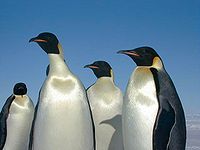

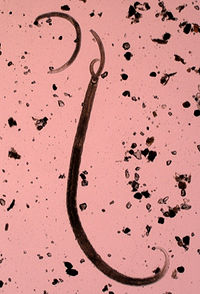
- All feliformsFeliformiaThe Feliformia are a suborder within the order Carnivora and includes cats , hyenas, mongooses, civets and related taxa. The other suborder of Carnivora is Caniformia...
, such as domestic cats, big cats, hyenas, mongooses, civets - Most caniformsCaniformiaCaniformia, or Canoidea , is a suborder within the order Carnivora. They typically possess a long snout and non-retractile claws . The Pinnipedia evolved from caniform ancestors and are accordingly assigned to this group...
, such as the dogs, wolves, foxes, ferrets, seals and walruses - All cetaceaCetaceaThe order Cetacea includes the marine mammals commonly known as whales, dolphins, and porpoises. Cetus is Latin and is used in biological names to mean "whale"; its original meaning, "large sea animal", was more general. It comes from Ancient Greek , meaning "whale" or "any huge fish or sea...
ns, such as dolphins, whales and porpoises - All batBatBats are mammals of the order Chiroptera "hand" and pteron "wing") whose forelimbs form webbed wings, making them the only mammals naturally capable of true and sustained flight. By contrast, other mammals said to fly, such as flying squirrels, gliding possums, and colugos, glide rather than fly,...
s (except fruitbats) - The carnivorous marsupialsDasyuromorphiaThe order Dasyuromorphia comprises most of the Australian carnivorous marsupials, including quolls, dunnarts, the numbat, the Tasmanian devil, and the recently extinct thylacine...
, such as the Tasmanian devilTasmanian DevilThe Tasmanian devil is a carnivorous marsupial of the family Dasyuridae, now found in the wild only on the Australian island state of Tasmania. The size of a small dog, it became the largest carnivorous marsupial in the world following the extinction of the thylacine in 1936...
Reptiles and birds
- All crocodiliaCrocodiliaCrocodilia is an order of large reptiles that appeared about 84 million years ago in the late Cretaceous Period . They are the closest living relatives of birds, as the two groups are the only known survivors of the Archosauria...
ns, such as alligators, crocodiles, gharials and caimans - All birds of preyBird of preyBirds of prey are birds that hunt for food primarily on the wing, using their keen senses, especially vision. They are defined as birds that primarily hunt vertebrates, including other birds. Their talons and beaks tend to be relatively large, powerful and adapted for tearing and/or piercing flesh....
, such as hawks, eagles, falcons and all vultures (Old and New World) - All owlOwlOwls are a group of birds that belong to the order Strigiformes, constituting 200 bird of prey species. Most are solitary and nocturnal, with some exceptions . Owls hunt mostly small mammals, insects, and other birds, although a few species specialize in hunting fish...
s - Some waterfowlWaterfowlWaterfowl are certain wildfowl of the order Anseriformes, especially members of the family Anatidae, which includes ducks, geese, and swans....
, such as gulls, penguins, pelicans, storks, and herons (Note, waterfowl is not being used in the taxonomic sense - e.g. Anseriformes - in this instance) - All snakeSnakeSnakes are elongate, legless, carnivorous reptiles of the suborder Serpentes that can be distinguished from legless lizards by their lack of eyelids and external ears. Like all squamates, snakes are ectothermic, amniote vertebrates covered in overlapping scales...
s, such as cobras, vipers, pythons and boas - Some lizardLizardLizards are a widespread group of squamate reptiles, with nearly 3800 species, ranging across all continents except Antarctica as well as most oceanic island chains...
s, such as most skinks and all monitor lizards - Some turtleTurtleTurtles are reptiles of the order Testudines , characterised by a special bony or cartilaginous shell developed from their ribs that acts as a shield...
s, including the alligator snapping turtleAlligator Snapping TurtleThe alligator snapping turtle is one of the largest freshwater turtles in the world. It is not closely related to, but is often associated with the common snapping turtle. They are the sole living member of the genus Macrochelys--while common snappers are in the genus Chelydra...
and most sea turtles
Fish and amphibians
- Most anurans, such as frogs and toads
- All sharkSharkSharks are a type of fish with a full cartilaginous skeleton and a highly streamlined body. The earliest known sharks date from more than 420 million years ago....
s, such as tiger, great white, nurse and reef sharks - Many bony fish, such as tuna, marlin, salmon, and bass
Invertebrates
- Some crustaceans, such as the coconut crab, though mainly omnivorous, will prey on turtle hatchlings, smaller crabs species, rats, and carrion
- Some molluscs, such as octopuses and squid, and some gastropods
- Most arachnidArachnidArachnids are a class of joint-legged invertebrate animals in the subphylum Chelicerata. All arachnids have eight legs, although in some species the front pair may convert to a sensory function. The term is derived from the Greek words , meaning "spider".Almost all extant arachnids are terrestrial...
s, such as spiders and scorpions - Many insectInsectInsects are a class of living creatures within the arthropods that have a chitinous exoskeleton, a three-part body , three pairs of jointed legs, compound eyes, and two antennae...
s, such as mantises, dragonflies and most wasps - All jellyfishJellyfishJellyfish are free-swimming members of the phylum Cnidaria. Medusa is another word for jellyfish, and refers to any free-swimming jellyfish stages in the phylum Cnidaria...
and sea starSea starStarfish or sea stars are echinoderms belonging to the class Asteroidea. The names "starfish" and "sea star" essentially refer to members of the class Asteroidea...
s - All centipedeCentipedeCentipedes are arthropods belonging to the class Chilopoda of the subphylum Myriapoda. They are elongated metameric animals with one pair of legs per body segment. Despite the name, centipedes can have a varying number of legs from under 20 to over 300. Centipedes have an odd number of pairs of...
s

